It may seem a bit previous to get into the subject of dressing for Kayak fishing, especially when there are some really interesting kayak subjects, like fitting out, and echo-sounders. But, having chosen the Ocean Kayak 4.7 Ultra, it was clear that the temptation to paddle off for some trial runs was going to make some weather and safety gear essential. So we’ll get on to the hardware soon.
One of the more interesting features of kayak fishing is that it’s quite technical, and that applies just as much to the clothing as it does the kayak, and the fishing itself. This is certainly not just a simple case of dressing warmly when it’s cold, and scantily when it’s hot.
It’s really important to understand that kayak fishing requires considerably more intelligent thought than a quick sortie on foot to the river. At the risk of stating the bleeding obvious, the additional consideration is the action of paddling the kayak. On a serene summer lake, progress might require nothing more than an occasional gentle sweep of the paddle, whereas to achieve any sort of forward motion through a four knot tidal sea race, will require a huge input of muscular effort, and that physical effort equals heat. Of course, the reality is that the vast majority of kayak fishing outings will be much more gentle affairs, but it’s as well to understand how things can be in extreme circumstances.
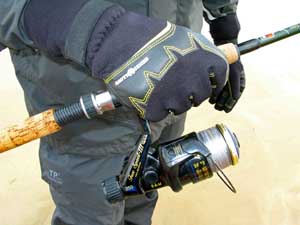 For advice on what to wear, we went along to the top marine weather-clothing experts at Henri Lloyd, who have been making state-of-the-art clothing for outdoor pursuits for over for over fifty years. We agreed to meet a member of their technical team to discuss the requirements.
For advice on what to wear, we went along to the top marine weather-clothing experts at Henri Lloyd, who have been making state-of-the-art clothing for outdoor pursuits for over for over fifty years. We agreed to meet a member of their technical team to discuss the requirements.
‘Ah,’ he said, ‘you’re going to have to get rid of a lot of water, of one sort or another.’
The point he was making, was that as well as protection from the elements: rain, wind, and spray; we would also have to consider the serious business of sweat. If you’re paddling like fury to get somewhere fast, or to overcome a fast tidal stream, then your body is going to perspire in an effort to cool the skin. Which is all very fine, until you stop, at which time that water can make you very cold indeed, so it’s desperately important to get rid of it as it is produced?
Here’s where the technology comes in. By using the latest breathable materials, the vast majority of body moisture can be vented away, leaving the skin dry, and comfortable. For kayak fishing, that also demands freedom of movement, and lightness, it was going to be essential to make some careful choices.
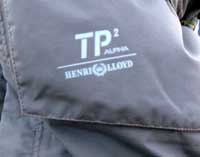 Given our four seasons, and the precocities of our weather, a tee-shirt and shorts just ain’t likely to be adequate, no matter how attractive that prospect appears. Kayak fishing requires more thought, and a bit of investment. You have to start somewhere, and Henri Lloyd’s suggestion was to use protective clothing based on their TP2 ALPHA material. This highly technical material is lightweight, but completely water and windproof, and at the same time ultimately breathable. It’s used in the Henri Lloyd Shadow range, which is usually subjected to the totally unreasonable demands of sports keelboat yacht racing, which is the sort of Formula 1 of sailing, so its pedigree is completely proven.
Given our four seasons, and the precocities of our weather, a tee-shirt and shorts just ain’t likely to be adequate, no matter how attractive that prospect appears. Kayak fishing requires more thought, and a bit of investment. You have to start somewhere, and Henri Lloyd’s suggestion was to use protective clothing based on their TP2 ALPHA material. This highly technical material is lightweight, but completely water and windproof, and at the same time ultimately breathable. It’s used in the Henri Lloyd Shadow range, which is usually subjected to the totally unreasonable demands of sports keelboat yacht racing, which is the sort of Formula 1 of sailing, so its pedigree is completely proven.
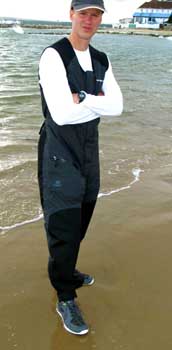
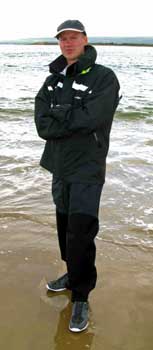
Base layer with salopettes and again with full jacket.
Mark wasn’t prepared to discuss his underpants in any way, so that area isn’t photographed here, but he was pleased to start with a HL Atmosphere Crew tee shirt. This essential layer wicks moisture away from the body, allowing it to pass out through the top layer. Although drainage on the Ocean Kayak 4.7 Ultra is highly efficient, there are still times when there is going to be water on the seat. You have two choices: accept a wet arse, or don’t.
Don’t is usually the favourite. Similarly there are times when splashed water from waves or paddling ends up in one’s lap. Short of donning absolute waterproofing top to toe, as you might sometimes, the answer is to wear waterproof trousers that rise to chest height: called salopetts. These leave arms and the upper body free, but protect the splash zone perfectly. In calm conditions and high summer, when shorts are a more attractive prospect, the same TP2 Alpha material is still appropriate. There’s never much to be said for a wet tailpipe.
At a point a waterproof jacket becomes essential. To match the TP2 Shadow Salopette Henri Lloyd make a (surprise, surprise) the TP2 Shadow Jacket, with all the same super breathable wonder. Mark had been inclined to the cool looks of the pull-on-over-the head smock. But the gurus at Henri Lloyd made one very useful observation about the choice; they suggested that the zip front version would be easier to put on and take off in the confines of a kayak; and that the ability to open the front zipper easily, would provide an extra level of ventilation, without having to remove the jacket completely. That made obvious sense, once it was pointed out.
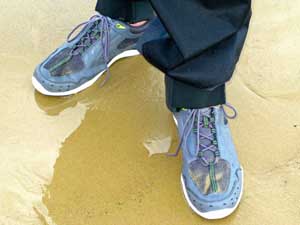 You see a lot of people paddling kayaks bare-footed. For messing around just off the tourist beach that’s probably OK., although even then I’d worry about stepping out onto the spines of a weaver fish. Mark will usually wear a pair of non-slip HL deck shoes, which are designed to tolerate being soaked in salt water. There will be many occasions when the kayak will be used to access deliciously remote and fishy islands and shores. Then, shoes are essential.
You see a lot of people paddling kayaks bare-footed. For messing around just off the tourist beach that’s probably OK., although even then I’d worry about stepping out onto the spines of a weaver fish. Mark will usually wear a pair of non-slip HL deck shoes, which are designed to tolerate being soaked in salt water. There will be many occasions when the kayak will be used to access deliciously remote and fishy islands and shores. Then, shoes are essential.
So that’s the basic outfit, and it should serve for at least six months of the year. For winter and early spring fishing, when air and sea temperatures are uncomfortably low, he’ll need to add a fleece wicking mid layer, and maybe two. Whatever you do, don’t wear cotton anything, and certainly, never, never, denim jeans. Cotton holds on to damp and makes you very cold indeed as that moisture evaporates, drawing heat from your body. Many seasoned kayak anglers use a dry suit, and for serious conditions and situations there is no doubt that this is the safest option.
We hope to report and review a dry suit later in the series.
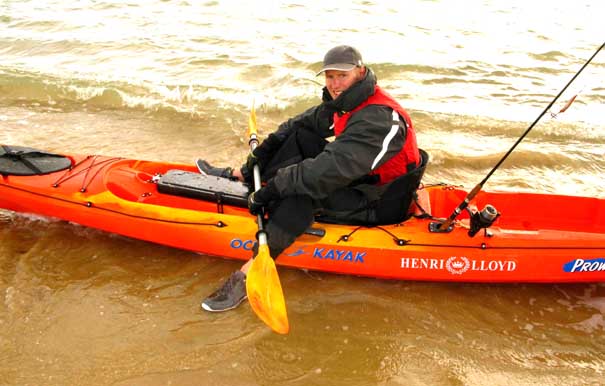
Ready for its first trial
New kayakers may have different ideas about what they would like to wear. Some, I’m aware, use chest-high waders with a cinched-in belt, and a waterproof top; but I must admit, the idea of being in deep water for any length of time with five gallons sloshing around in my chesties, wouldn’t appeal to me; not even with the clingy neoprene types. Maybe it would be safe enough for 95% of the time, but I simply can’t see any sense in taking ANY risk, when there is an alternative. The outfit suggested is proven, and safe for calm conditions. The best place to buy is at a reputable marine clothing shop. Buy the best you can afford, and it will last for years.
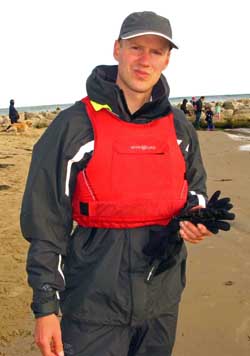 And remember, whatever your choice of clothing, the absolutely essential top layer is a buoyancy aid suitable for your body weight. No matter how short your excursion and no matter who you believe is on hand to haul you out of the drink – ALWAYS wear a buoyancy aid. There are several other items of equipment that should be considered essential, and we will talk about those in a future essay.
And remember, whatever your choice of clothing, the absolutely essential top layer is a buoyancy aid suitable for your body weight. No matter how short your excursion and no matter who you believe is on hand to haul you out of the drink – ALWAYS wear a buoyancy aid. There are several other items of equipment that should be considered essential, and we will talk about those in a future essay.
This may all sound desperately complicated. The reality is that a good kayak dealer and a good marine clothing supplier will be able to fix you up very quickly with everything you need. Kayak fishing is booming because it’s huge fun, so you will find it comparatively easy to find friends who can help to get you going. In the meanwhile we hope you will follow the progress of our kayak fishing project.












